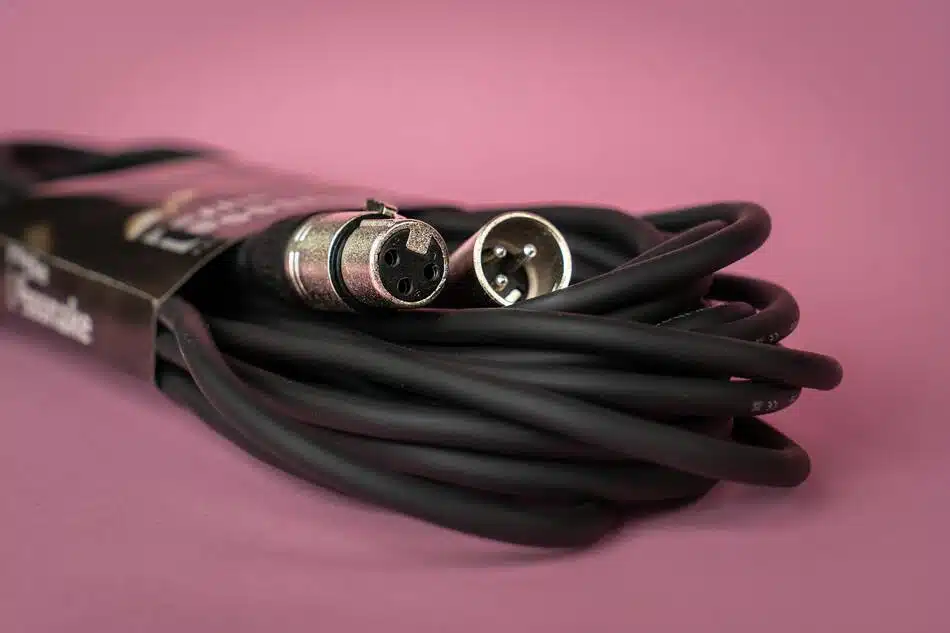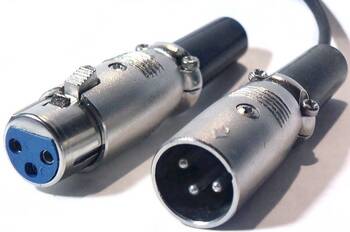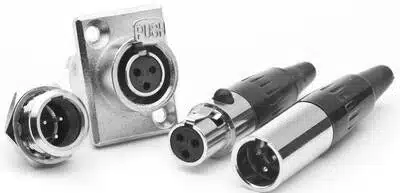
With so many XLR cable brands available today, many newbies looking to get into the pro audio world always seem to have the question, “are all XLR cables?” And it is a very valid question because visually, all XLR cables look quite identical. But does that mean they are the same?
Although all XLR cables are used to transmit audio from one device to another, they are all not the same. Some XLR cables have regular-sized connectors, while others have Mini-XLR connectors. Also, XLR cables vary in build quality and wire gauge size.
First, let’s talk about the different types of XLR cables available and how they differ. And we’ll follow that up with some of the things that separate XLR cables from one brand to another. Let’s get into it.
Table of Contents
Different Types of XLR
There are two types of 3-pin XLR that are used in the audio industry. I will talk about them briefly in a moment.
Regular-Sized XLR

Regular-sized XLR microphone cables are the cables that come with standard-sized 3-pin XLR connectors. This regular XLR microphone cable is what is widely used in audio settings. Thus, whenever the term XLR is being used, this standard-sized 3-pin XLR connector is being referred to.
These XLR cables are used to connect microphones to mixer boards, portable speakers, and many others. They are also used to connect mixer boards, amplifiers, and wireless receivers together.
If you are interested in learning more about this particular XLR, you should read this article.
Mini XLR

Just as the name suggests, the mini XLR is basically a smaller version of the commonly used XLR microphone cable. The main difference between this mini XLR and the regular XLR is the size of their XLR connectors.
The XLR connectors that come attached to mini XLR cables are relatively smaller than the regular XLR.
Due to this, this mini XLR microphone cable is usually used on smaller equipment like some field and studio recording headphones. It is also used in some mixing desks and for connecting some condenser microphones and UHF wireless microphone beltpacks as well.
Differences That Exist Between XLR Cables
Build Quality of Cable: Durability and Flexibility
The build quality of XLR cables is the major difference that exists between XLR cables. The build quality of an XLR cable directly affects its flexibility and durability.
This is because XLR cables made from high-quality materials are always thicker than those made from inferior materials. High-quality XLR cables have thick outer jackets that protect them from damage. Due to their thickness, high-quality XLR cables last longer than inferior ones.
The type of material used in making high-quality XLR cables makes them flexible as well. Flexible cables are able to withstand heavy abuse. High-quality XLR cables can be bent without breaking.
The flexibility of an XLR cable depends on its strand count. Cables with a high number of strand counts are very flexible.
Also, the insulation and outer jacket of high-quality cables are made from special materials that provide it with great impact absorption. This improved impact absorption becomes useful whenever the cable gets stepped on or hits the stage since it ensures that the cable does not get compressed or damaged.
On the other hand, inferior XLR cables have relatively thinner outer jackets than high-quality ones. The outer jackets of these inferior XLR cables tend to be hard, which causes them to break easily.
Their insulation and outer jackets do not over great impact absorption whenever they are subjected to stress. They are not flexible as well. All these make the cable less durable. Thus, when these inferior XLR cables are subjected to any impact, they give way.
Therefore, the main distinguishing factor among XLR cables is their build quality. This build quality directly translates into their flexibility and durability.
Cable Shielding: EMF Interference Rejection
All XLR cables are able to reject electromagnetic interference to a large extent. However, how well XLR cables reject these electromagnetic interferences varies from one cable to the other.
Some XLR cables have superior rejection over others. Thus, the ability of XLR cables to reject EMF interferences is one of the few things that distinguish one XLR cable from the other.
How good an XLR cable is able to reject EMF interference depends on the nature of its shielding. Shielding in this context simply means the ability of a cable to combat the effects of electromagnetic interference.
Properly shielded XLR cables have high interference rejection than badly shielded cables. High-quality XLR cables are properly shielded. They are usually shielded with braided copper or flat copper strands.
Braided shielding offers excellent shielding against hi-frequency and interference. They function by protecting the wire conductors inside the cable from interference. The shielding also serves to increase the durability of the XLR cable.
On the other hand, low-quality XLR cables are not properly shielded. They are shielded with foil wrappings that have been combined with copper drain wire. These do not offer great and effective shielding against hi-frequency and interference.
It is quite difficult to notice this variation in EMF interference in ambient conditions or environments. However, this difference will be highlighted when XLR cables run close to high-power radio towers.
XLR cables with low EMF interference rejection might end up picking up EMF interference that may even be louder than the audio signal being transmitted. If you have done a gig where you had to run your cables on the top of high-rise buildings, you might have experienced what I am talking about.
Wire Gauge
Wire gauge is another difference that exists between XLR cables. The term wire gauge simply refers to the size of the wire. The higher the gauge, the smaller the wire and vice versa. XLR microphones come in different sizes or gauges.
XLR cables come in varying gauge sizes. Most XLR microphone cables have a gauge of either 22 or 24. Some have a gauge of 16. However, you should note that as long as an XLR cable is of good quality, you do not need to worry much about its size.
Does It Matter What XLR Cable I Get?
With regards to sound quality, the type of XLR cable you get does not matter. This is because, under normal conditions, the quality of sound produced by an XLR cable is not influenced by the quality of the XLR cable.
The sound quality is influenced by the microphones connected to the XLR cables or the audio quality of audio being run through the XLR cable. What this means is, under such conditions, every XLR cable will basically output audio signals of the same quality.
The only time difference in sound quality will be noticed between two XLR cables is when one of them is broken or when they are used close to high power radio towers.
What this means is, if you don’t intend to ever use your XLR cable close to high power radio towers, all you need to do is make sure your inferior XLR cable is always in good condition and undamaged.
Also, if you intend to use your XLR cables in a home recording studio where all your gears will be already connected, and you don’t move them often, cheap and inferior XLR cables can do the job just fine. The XLR cables are less likely to damage in a fixed setup.
However, if you intend to use these XLR cables in a live environment or outdoor gigs, you want to go for high-quality XLR cables with a solid build.
In a live situation, your XLR cables will be stepped on, pulled accidentally multiple times. And due to this, you need an XLR cable that can withstand all of these. This is why expensive XLR cables are required for live environments and outdoor events.
Low-quality XLR cables are not durable. Thus, they tend to get broken or damaged after using them for a relatively short among of time.
Since any damaged XLR cable will generate a sound of low quality, these inferior XLR cables will start doing exactly that when they get damaged. When this happens, you have to part away with money to replace them.
Unfortunately, since inferior XLR cables get damaged regularly, in the long run, you will end up spending lots of money replacing them.
Therefore, though the type of XLR cable you use does not matter when it comes to the quality of sound they output, it is not a good idea to go in for inferior XLR cables.
You want to purchase great quality XLR cables if you intend to use them for a long time, especially if you use them outdoors.
This is because inferior XLR cables do not last long. Due to this, economically, you will end up spending a fortune on replacing them whenever they get damaged after using them for a short while.
In summary, the build quality of an XLR cable does not affect the quality of sound that is produced. The build quality of an XLR cable only affects the durability of the cable.
Which Brands Produce Good XLR?
I will try to keep this as brief as possible. When it comes to cables, the brands you can rely on include Mogami, Gotham, Canare, and Belden. You should definitely be on the lookout for these brands when you go cable shopping.
These are recognized brands that are known for making high-quality audio cables, and you won’t go wrong when you select from any of them.
If you’re looking for a recommendation, then Mogami’s Gold Studio-10 XLR Cable (on Amazon) is an excellent choice. Many professional audio engineers and studios go for this XLR cable, and it always gets the job done. You’re going to use this for a long time before it shows any sign of deterioration.
Nowadays, most people prefer to build their own XLR cable from scratch. So I cannot talk about XLR brands without talking about Neutrik. This company is known to produce high-quality XLR connectors.
One thing you should know is that high-quality cables fitted to crappy connectors will give you problems at some point. Crappy connectors do not give secure connections and may get stuck or fail to lock in properly.
These poor connectors can even pop out of microphones when there is a slight tug on them. After repeated use, they fall apart as well.
XLR connectors manufactured by Neutrik provide complete shielding to your XLR cables. They are durable as well. Neutrik also produces speaker connectors known as Speakon. Read this article to learn about Speakon.
Are All Microphone Cables XLR?
Not all microphone cables come as XLR. All standard professional microphones are manufactured around the XLR cable. Particularly the 3-pin XLR. However, there are other microphones that have been designed specially to accept connections from non-XLR cable sources.
Some of these microphones include USB microphones and some mini-wireless microphones. These microphones have their microphone cables be USB or 3.5mm cables.
What this means is that there are microphone cables that are not XLR. However, the majority of the microphones that are manufactured are XLR microphones. This is because XLR microphone cables are the audio industry’s standard cable connector for microphones.
Therefore, even though some microphones may be designed to accept non-XLR cables like 3.5mm or USB, the absence of XLR in these microphones may suggest that they are not professional quality microphones.
Conclusion
In summary, technically, all XLR microphone cables are the same. This is because they have the same framework of design and perform the same functions as well.
However, structurally, they may not be the same. XLR microphone cables may vary based on the type of XLR connector attached to them. Also, XLR microphone cables differ with respect to material makeup, build quality, and overall wire size.

Hello, I’m Elijah. A writer on Geek Musician, based in Ghana-West Africa. I am a writer with a passion for research and reading. I usually spend my free time playing chess or watching movies. For more info, check out my about me page. Or read more of my articles here.

